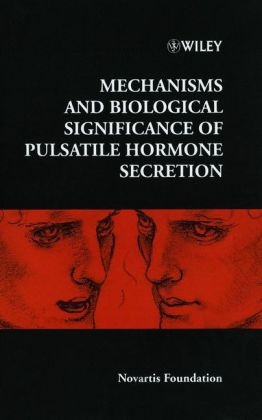Read more
Zusatztext "This book provides a comprehensive and excellent summary of our state of knowledge!"(Cell Biology International! May 2001)"This outstanding text should stimulate further research on pulsatile hormone secretion that will enhance both biomedical science and clinical treatments of hormone-related disorders"(Trends in Endocrinology & Metabolism! August 2001) Informationen zum Autor Derek J. Chadwick and Jamie A. Goode are editors for Mechanisms and Biological Significance of Pulsatile Hormone Secretion and other scientific titles. Klappentext Mechanisms and Biological Significance of Pulsatile Hormone Secretion Chair: Johannes D. Veldhuis 2000 Many endocrine systems use the intermittent or pulsatile release of hormones to transmit complex information into cellular compartments of the body. Although the actual concentration of a particular hormone is clearly important in endocrine signalling, valuable information is also encoded by the frequency of hormone release. In addition, circadian and seasonal rhythmicity also characterize the action of many hormones. This exciting book brings together an international group of basic and clinical scientists to discuss the importance of pulsatile signalling in the induction of biological responses. Coverage includes the basic mechanisms involved in hormone pulsatility, the significance of pulsatility in normal and disease conditions, the relevance to circadian rhythms, changes with ageing, and detailed consideration of specific peptide hormone systems. This book includes papers by many leading experts in this field, together with extensive discussions which reveal much new and exciting work in this area and identify promising new research directions. Zusammenfassung In vertebrates, the endocrine system plays a key role in conveying environmental temporal information to changes in physiology. This book reviews the biological basis of pulsatile hormone release, exploring the current state of knowledge of pulsatile hormone secretion in health and disease. Inhaltsverzeichnis Introduction (J. Veldhuis). Rhythmic Transcription: The Molecular Basis of Oscillatory Melatonin Synthesis (N. Foulkes, et al.). The Frequency Encoding of Pulsatility (A. Goldbeter, et al.). Timing-Dependent Modulation of Insulin Mitogenic Versus Metabolic Signalling (P. De Meyts & R. Shymko). Growth Hormone Pulse-Activated STAT5 Signalling: A Unique Regulatory Mechanism Governing Sexual Dimorphism of Liver Gene Expression (D. Waxman). Orderliness of Hormone Release (S. Pincus). Prediction and Significance of the Temporal Pattern of Hormone Secretion in Disease States (G. Brabant & K. Prank). Therapeutic Implications of Circadian Rhythms in Cancer Patients (F. Lévi). Pathophysiology of Human Circadian Rhythms (G. Copinschi, et al.). Nature of Altered Pulsatile Hormone Release and Neuroendocrine Network Signalling in Human Ageing: Clinical Studies of the Somatotropic, Gonadotropic, Corticotropic and Insulin Axes (J. Veldhuis). Pulsatile Insulin Secretion (P. Butler). Control of Growth Hormone (GH) release by GH Secretagogues (I. Robinson). Pulsatile Parathyroid Hormone Secretion in Health and Disease (F. Schaefer). Significance of Pulsatility in the HPA Axis (S. Lightman, et al.). Closing Remarks (J. Veldhuis). Indexes....
List of contents
Introduction (J. Veldhuis).
Rhythmic Transcription: The Molecular Basis of Oscillatory Melatonin Synthesis (N. Foulkes, et al.).
The Frequency Encoding of Pulsatility (A. Goldbeter, et al.).
Timing-Dependent Modulation of Insulin Mitogenic Versus Metabolic Signalling (P. De Meyts & R. Shymko).
Growth Hormone Pulse-Activated STAT5 Signalling: A Unique Regulatory Mechanism Governing Sexual
Dimorphism of Liver Gene Expression (D. Waxman).
Orderliness of Hormone Release (S. Pincus).
Prediction and Significance of the Temporal Pattern of Hormone Secretion in Disease States (G. Brabant & K.
Prank).
Therapeutic Implications of Circadian Rhythms in Cancer Patients (F. Lévi).
Pathophysiology of Human Circadian Rhythms (G. Copinschi, et al.).
Nature of Altered Pulsatile Hormone Release and Neuroendocrine Network Signalling in Human Ageing: Clinical
Studies of the Somatotropic, Gonadotropic, Corticotropic and Insulin Axes (J. Veldhuis).
Pulsatile Insulin Secretion (P. Butler).
Control of Growth Hormone (GH) release by GH Secretagogues (I. Robinson).
Pulsatile Parathyroid Hormone Secretion in Health and Disease (F. Schaefer).
Significance of Pulsatility in the HPA Axis (S. Lightman, et al.).
Closing Remarks (J. Veldhuis).
Indexes.
Report
"This book provides a comprehensive and excellent summary of our state of knowledge,"
(Cell Biology International, May 2001)
"This outstanding text should stimulate further research on pulsatile hormone secretion that will enhance both biomedical science and clinical treatments of hormone-related disorders"
(Trends in Endocrinology & Metabolism, August 2001)

